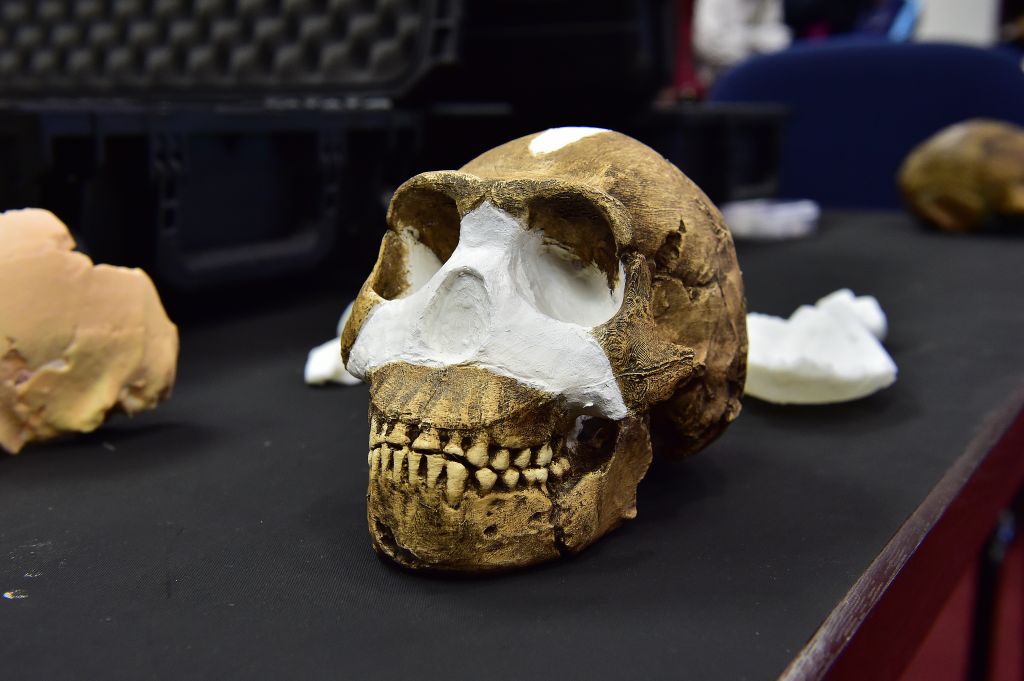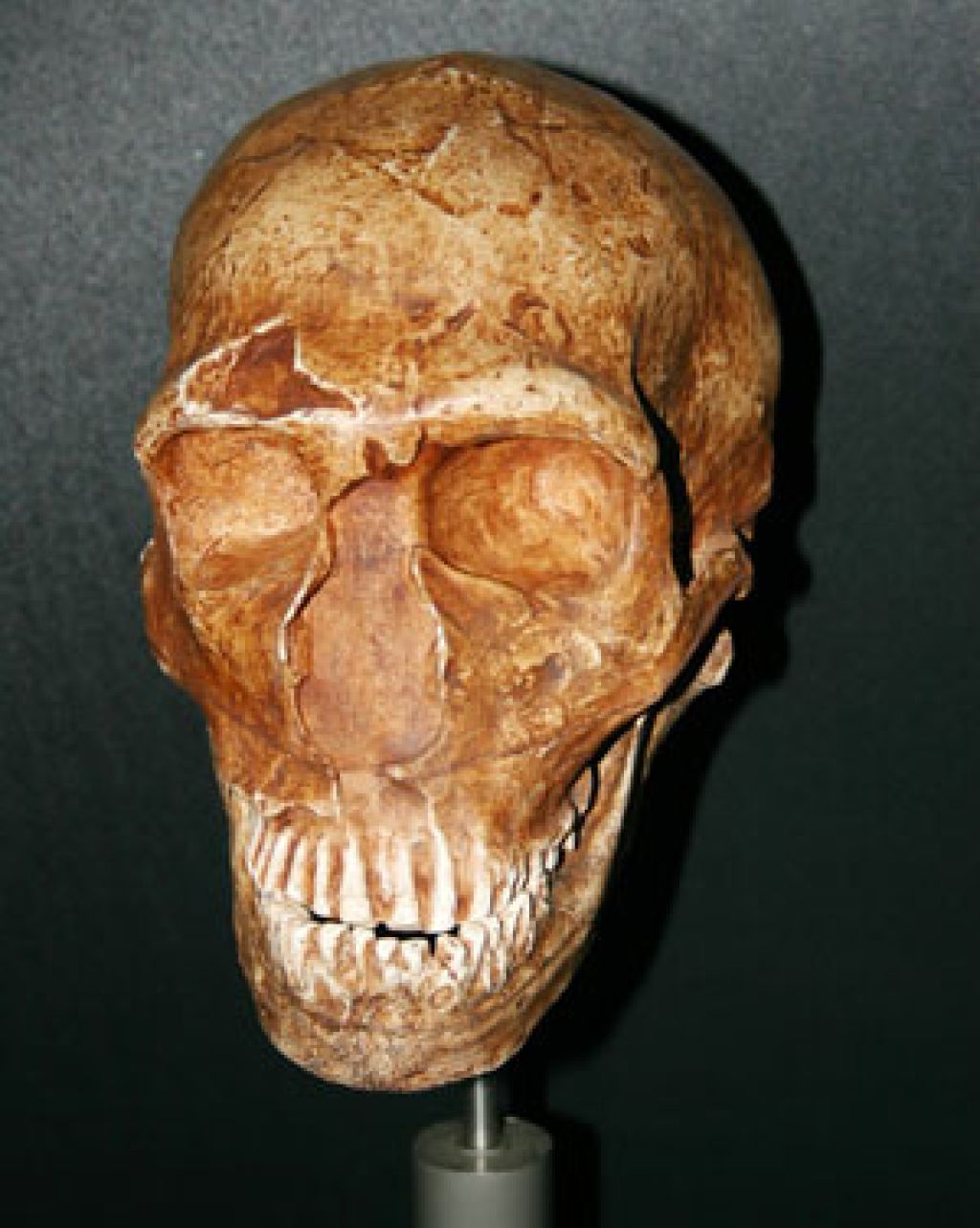Homo
Humans are the last surviving species in the genus Homo.
Homo habilis
The earliest species of the genus Homo named so far, Homo habilis (“Handy Man”), appeared about 2-million years ago in Africa. Homo habilis had smaller teeth and a larger brain than Australopithecus (about 600 cc to 800 cc), and was probably the first hominid to make stone tools, including pebble choppers and sharp flakes of stone.
These tools, referred to as the Oldowan industry, were used to cut, crush and grind food. The ability to use tools to process food meant that Homo habilis was not as reliant on large teeth, powerful jaws and heavy cheek muscles as its predecessors. By contrast, their faces were more slender, or gracile, and their teeth smaller than their contemporary in South Africa, Paranthropus robustus, for example, which mostly ate tough vegetation.

It was probably the development and use of tools that would save the Homo lineage from extinction, as it was able to adapt to changes in the Earth’s climate at the onset of the Pleistocene, which was marked by a cycle of ice ages beginning about 1.8-million years ago. All together, Homo habilis lived for more than half a million years.
The first Homo habilis fossil was discovered at Olduvai Gorge in Tanzania in the early 1960s. It consisted of two parietal (skull) bones and the lower jaw of a child. Other examples of Homo habilis are the 1470 skull from East Lake Turkana in Kenya, and the OH 65 maxilla (upper jaw) from Olduvai Gorge in Tanzania.
Homo ergaster
The successor to Homo habilis in the fossil record is Homo ergaster, sometimes known as early Homo erectus from Africa, which lived between about 2-million and 1.4-million years ago and had a brain capacity of about 850 cc to 900 cc (about two-thirds of the size of modern humans).
The first discovery of Homo ergaster was made by Transvaal Museum palaeontologists Dr Robert Broom and John Robinson at Swartkrans in the Cradle of Humankind in 1949, when they found a lower jaw (mandible) SK 15 and a cranium SK 847, which was only recognised as Homo 20 years later by Ron Clarke.
Palaeoanthropologists believe Homo ergaster was the first human ancestor to have made Acheulean stone tools, such as hand-axes and cleavers, which were an improvement on the earlier Oldowan technology.
Tools, combined with the ability to control fire, allowed Homo ergaster to leave Africa for colder, northern climates. The use of fire allowed for cooking, which expanded the range and quality of foods available to Homo ergaster. It also provided warmth, and a means to ward off predators.
Physical characteristics
Homo ergaster was about as tall as modern humans and always walked upright, but still had a few ape-like features, including a low forehead with prominent brow ridges, a slightly thickened jaw and no discernible chin.
The “Turkana Boy”, found near Lake Turkana in Kenya in 1984, is the most complete Homo ergaster specimen ever discovered. The boy, who died at about the age of 12, walked upright, had arms and legs in proportion to those of a modern human’s and was already 1.6 m (5’ 3”) tall.
Homo erectus
Homo erectus’ most prominent features were its low, angular braincase with massive browridges, and large brain of up to 1250 cc, which comes close to modern human brain sizes. Most palaeoanthropologists now believe that Homo erectus evolved in Asia about 1.6-million years ago, and used its relatively advanced mental capabilities to spread into Europe and Africa.
In 1891, Eugene Dubois found a fossilised 700,000-year-old Homo erectus skullcap at Trinil on the Solo River, Java, Indonesia, and named it Pithecanthropus erectus. Later dubbed “Java Man”, this is the type specimen for Homo erectus. Since then, dozens of Homo erectus fossils have been recovered from Java.
In the 1930s, about 40 Homo erectus fossils were excavated at Zhoukoudian, China. Originally classified as Sinanthropus pekinensis, and known more popularly as “Peking Man”, the fossils date from about 530,000 to 230,000 years ago, and are less robust than the Java specimens.
Although most Homo erectus specimens have been discovered in Asia, they have also been found in Africa. Homo erectus fossils found at Olduvai Gorge, Tanzania, date to between 1-million and 800,000 years ago. Apparent ancestors of Homo erectus have been found in Dmanisi, Georgia, dating to 1.8-million years ago and having small brains like Homo habilis. One theory is that Homo habilis spread into Europe and Asia from about 2-million years ago, where it evolved into Homo erectus, which then spread further in the northern hemisphere, as well as back into Africa.
In 1994, a very thick braincase of Homo erectus, fragmented by a bulldozer, was discovered in Ceprano, Italy. Dating to between 900,000 and 740,000 years old, the cranium shows that Homo erectus spread into Europe far earlier than palaeoanthropologists had at first thought.
Our recent ancestors
Researchers continue to investigate the links between ourselves, Homo sapiens, and various Homo species which lived within the past 1-million years.
Homo antecessor
Homo antecessor (Latin for “pioneer” or “explorer”), a species discovered in Spain dating to about 800,000 years ago, may bridge the gap between Homo erectus and Homo heidelbergensis, which lived in Europe between about 600,000 and 300,000 years ago. Homo antecessor may even be a direct ancestor of Homo sapiens.
Homo sapiens idaltu
Homo sapiens idaltu, a more recent ancestor, was found in Herto, in Ethiopia, and is dated to about 160,000 years ago. Important finds of archaic (early) Homo sapiens similar to Homo sapiens idaltu have also been made at Omo, Ethiopia, dating to about 195,000 years ago, and in South Africa, at Florisbad in the Free State, dating to about 250,000 years ago. Present fossil information thus suggests that our species – Homo sapiens – first emerged in East or Southern Africa.
Homo naledi

Homo naledi was discovered in the Dinaledi cave system in the Cradle of Humankind in September 2013. The new species was revealed to the world at Maropeng on 10 September 2015. The species, which has not yet been dated, was discovered as part of the largest collection of hominin fossils ever found in Africa. Homo naledi, stood at around 1.5m tall, had a small brain and a primitive torso. Its feet however, were remarkably human-like, and it had powerful, unique hands.
More intriguingly, a large collection of Homo naledi fossils of individuals of all ages were discovered in remote cave chamber in a manner that suggested that the bodies had been deliberately disposed of - a trait that has previously been thought to be unique to humans. The discovery was covered extensively in National Geographic.
Homo heidelbergensis and Homo neanderthalensis

In Europe and western Asia, Homo heidelbergensis, a tall, big-boned hominid (see the life-size model of it elsewhere in the Maropeng exhibiton), gave rise to Homo neanderthalensis, a robust, heavy-boned, muscular species, which lived from about 200,000 to 20,000 years ago, becoming extinct following the appearance there of modern humans.
Homo sapiens
From 200,000 to 150,000 years ago, Homo sapiens in Africa would have looked much the way we do today, but with more prominent browridges. By at least 70,000 years ago, and perhaps earlier, this species was beginning to display complex behavioural attributes which we associate with ourselves. Both anatomical and behavioural modernity had been achieved by the time Homo sapiens started to spread out from Africa to the rest of the world between about 60,000 and 40,000 years ago, in a movement known as “Out of Africa II”.
Why did Homo emerge?
The reasons for the emergence of Homo continue to be debated. Plausibly, a taller, finer-featured hominid would have taken advantage of an African environment that was changing and opening up, with savannah replacing forest. Homo’s longer legs and bigger brain allowed the species to pursue new food sources further afield.
Return to the Exhibition Guide.